Eating burnt sheep's head
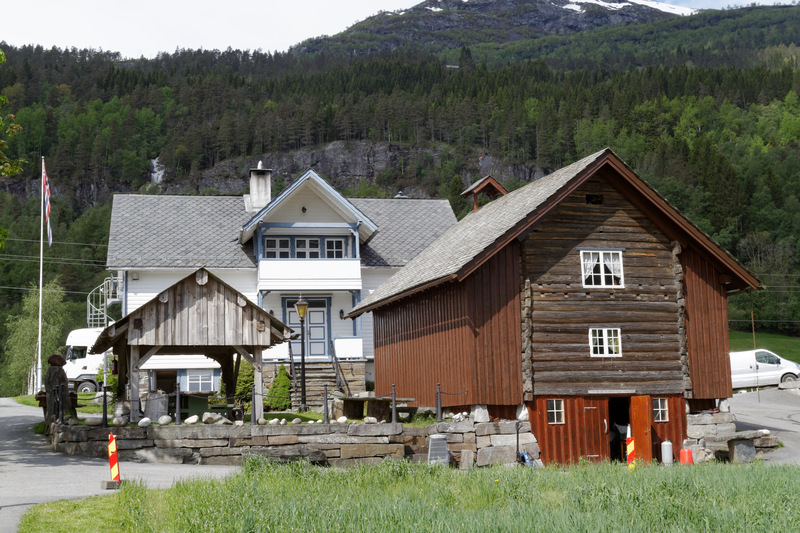
Smalahovetunet |
We'd booked a lunch at Smalahovetunet, for two reasons. One was that they served the local delicacy smalahove, which really is burnt, smoked sheep's head. The other was that they'd promised to serve us traditional Voss home brew with the food. So we drove the 8 kilometers from Voss up to the farm, in an idyllic setting by the lake in the middle of the valley above Voss. (This is part 2 of the Norwegian farmhouse ale trip.)
Our host, Ivar Løne, took us to a gorgeous old wooden building, a food storehouse dating from the 18th century. There he brought us an ølkjenge, a wooden beer bowl, filled with home brew. And there it was again! That citrusy aroma of kveik, this time blended in with some banana and alcohol. It had a clear family resemblance to Sigmund's beer, without being the same.

Martin checking the beer |
Then, Ivar took us off to see the brewery, in a small cellar underneath one of the houses. The similarities with Sigmund's brewery were striking, but this one was clearly older. Here, the huge copper kettle hung on chains over an open fireplace. The steel buckets, the garden hose, the steel serving tank. All this was pretty much the same. Even the fermentation vessels looked much the same, but Ivar had two of them, both busily fermenting away.
We asked Ivar how he brewed, and quickly established that the basics were the same as with Sigmund. He uses juniper infusion, and ferments at roughly 38C, using his own strain of kveik. He boils for 3-4 hours and says initially, if you take a ladle of wort you can't see the bottom of the ladle. After 1.5 hours of boiling the wort in the ladle begins to clear, and after three hours it will be pretty much bright and clear. He seems to only mash for one hour.

The kveik at work |
And then, in an aside, he lets slip that in Hardanger there are also home brewers using kveik. "And there people say it's 350 years old," he adds. This is fantastic news, except that after the initial research we decided to skip Hardanger as not interesting enough. So we're going north from Voss, away from the kveik. This is intensely frustrating, but there's nothing we can do about it now.
Ivar then took us back to the old storehouse, this time going inside. We sat down at the rough-hewn wooden benches and tables, and waited. Soon, Ivar showed up again, with three steaming halves of sheep's head in a wooden tray. The heads seem shrunken and wrinkly from the water, yet fatty, and disconcertingly head-like. Seemingly empty eye sockets stared at us, although we were soon to learn that they were anything but.
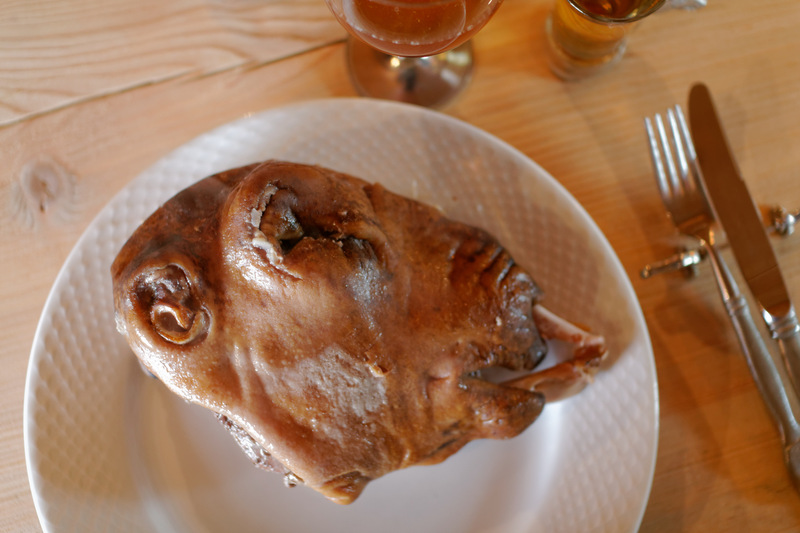
Ready to eat |
And there I am. A sheep's head is lying on my plate, its jaw bones protruding out of what was once the mouth. I poke at it, not sure where to begin, so Ivar takes over. He expertly flips open the eye socket, takes out the eye, removes the black bit in the front, then puts in on the plate. Quickly, to stop myself from thinking too much about what I'm doing, I put the eye in my mouth, and chew. To my surprise, it's not slimy at all, but soft and chewy, rather like fat. It doesn't really taste of anything special.
Emboldened by this discovery, I start on the head itself. The meat is tender, almost falling to pieces, after having been boiled for hours. It tastes recognizably like mutton, with a delicate smoked character. Martin is really taken with the smoke flavour, and immediately starts wondering what sort of wood they've used. We quickly forget what it is we are eating and tuck in, because this really is delicious.
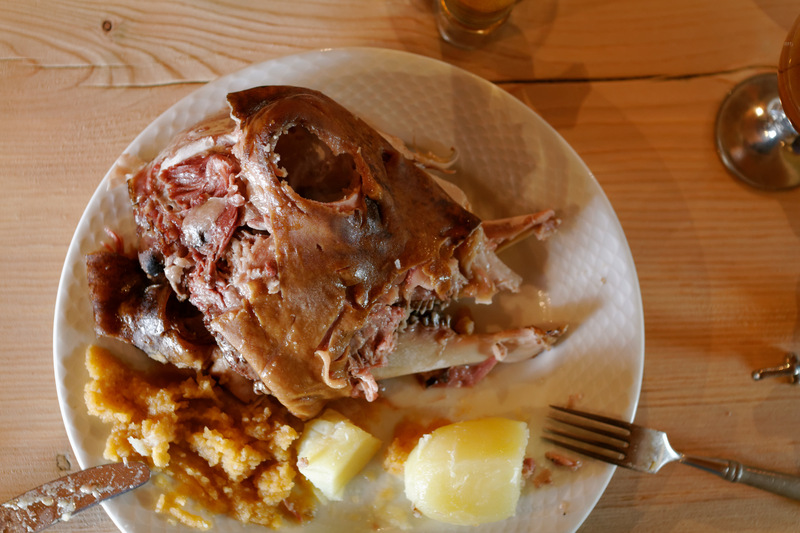
Tastes a lot better than it looks |
We're served home brew to go with the food, and the beer nicely complements the food. I can pay more attention to the beer this time around, and notice a clear juniper presence all the way through. The beer is kind of sweet, with no carbonation. At the beginning the citrus and banana character from the kveik dominates, but gradually that fades, to be replaced by juniper and alcohol, even solvent. It's a good beer, and very unlike anything else I've had. As with Sigmund's beer, the beer really seemed dominated by the kveik character. The closest equivalent in flavour I can think of is Finnish sahti, but the yeast profile in that is not nearly as pleasant, probably because of the bread yeast they use. This is also clearly stronger than sahti.
We work our way through the heads, which are actually just halves of a head, eating jaw muscles, ears, the top of the snout, the tongue, and so on. By now this feels totally natural, and I have no qualms about eating sheep's head. Once we've finished, Ivar's wife takes away the remains of the sheep's heads, then brings us new trays of pinnekjøtt and sausage. We burst out laughing. We'd completely forgotten that we ordered the menu that had both smalahove and other dishes, so the Canadians could get to try various types of traditional food. By now we're full to bursting and really hadn't planned to eat any more.
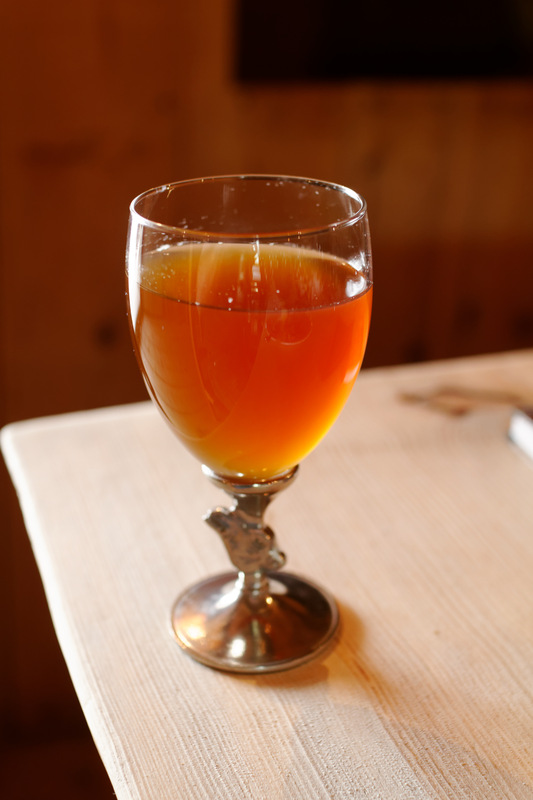
The beer |
After a quick discussion we agree that if we skip dinner, for which we have no plans anyway, we could perhaps squeeze in some more. And we do. Martin takes one bite of pinnekjøtt and immediately exclaims "this is the same wood! It's smoked with the same type of wood! I have to find out what this is." We ask, and are told that in Voss, everything is smoked with alder wood, which does indeed give a very characteristic aroma.
After we've eaten as much meat as we feel is safe, Ivar's wife takes away the remains, and comes back with cake and coffee. We start laughing all over again. Cake? How are we going to find room for cake? Eventually we squeeze down a token amount, to avoid giving offense, then sit groaning quietly for a while.
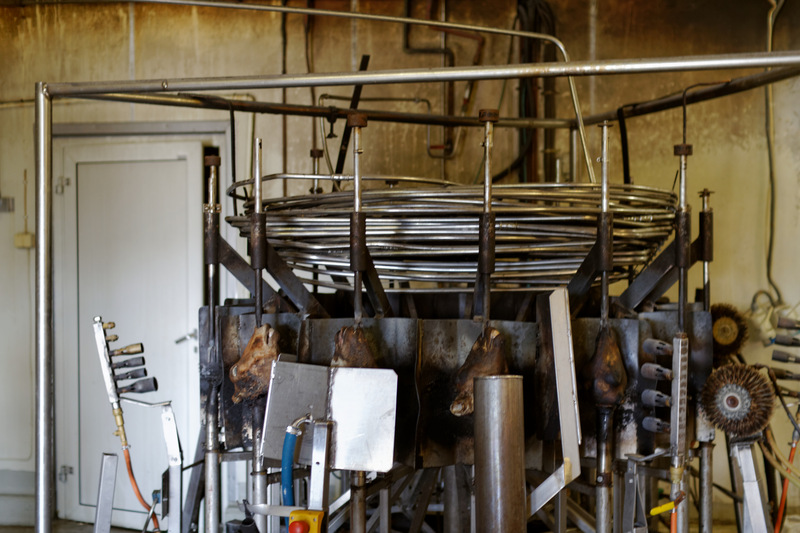
The nightmare machine |
The comes the final event: the visit to the smalahove factory. We stagger down to another part of the farm, where there's a big warehouse-like building. Inside is a bizarre contraption, like a merry-go-round, except it's all sooty steel, and what goes round are sheep's heads impaled on metal poles coming out their nostrils. This already looks pretty odd, but then Ivar's son starts the machine. The heads start going round, as expected, but then they stop in front of rows of odd-looking cylinders.
Suddenly, the cylinders spew blue and yellow flame, totally enveloping the heads. In their now-blackened faces, bits of wool glow red. I lift my camera and start shooting pictures of white teeth in black faces, grinning in gruesome smiles, bathed in bright yellow flame. It's like a dream-vision of an industrialized hell for sheep. Then the flames stop, the heads move one step around the machine, and the heads are scoured by rotating steel brushes, scraping the burnt wool from their faces. The scraping stops, the heads move another position, and the flamethrowers let rip again.
The purpose of this process is to remove the wool without flaying the heads. Exactly why they don't simply flay the heads I can't really say. Other places in the country they flay them instead.
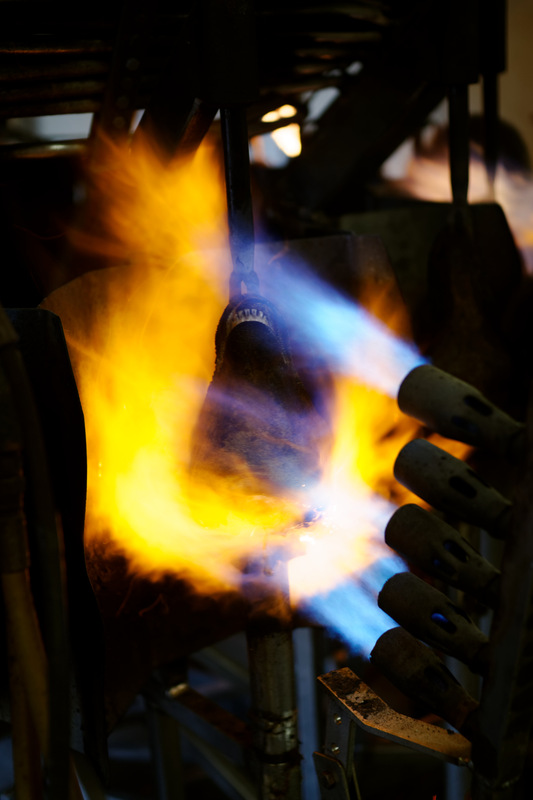
Once you've seen it, you won't forget it |
Our guide takes another head, poses for us with it, then sticks it in another machine, pulls a lever, making a crunching sound. Now he can tear the head in half with his fingers, and point to the various parts inside, explaining what's eaten and what not. From here, the heads go to the smokehouse, where chips of alder wood are kept smoldering to produce the smoke. Once smoked, the head can be stored for a good while before being eaten.
Smalahovetunet is actually the only place in Norway with a license from the food safety authority to produce smalahove. So they make 70,000 heads a year. That's 140,000 portions. If you buy smalahove in Norway, it comes from Smalahovetunet. You can see why they need a machine, and in fact the machine was built specifically because they were struggling to produce enough smalahove the traditional way.

Scraping |
Later, Ivar tells us that the machine was designed by a local artist. Which makes total sense, because while obviously functional, you could put it in a contemporary art museum as an exhibit for the industrialization of food processing, and the inherent barbarity of producing food from animal bodies. When we visit him to taste the beer we brewed, Sigmund tells us a little more. The designer, Leif Gjerme, was a friend of his, and he worked as both an inventor and an artist. He was not an engineer, and knew very little maths, so he did no drawings, but instead visualized the entire machine in his head. Complete with wirings, hydraulic pipes and pumps, the timing of the various parts, etc etc. He did this so thoroughly that when he built the prototype, it worked on the first attempt.
Stuffed, happy, and slightly dazed, we go back to Ivar's wife to settle the bill. And now we discover that we don't actually pay for the beer, only for the food and the tour. We're told that they do have approval from the food safety authority for producing the beer, but the tax regime for selling beer is so complicated and cumbersome that they have decided not to even try selling it.
We consider this silently. The Ratebeer database has more than 265,000 different beers. Of those 1 is made with kveik. If someone travels to Voss to try what is by far the most unique food product in Voss, and one of the most unique beers on earth, they will find that they cannot buy it. The only option is a massive dinner, booked for a group in advance, with the beer thrown in for free. If you remember to ask for it.
(Martin's blog post about Smalahovetunet.)
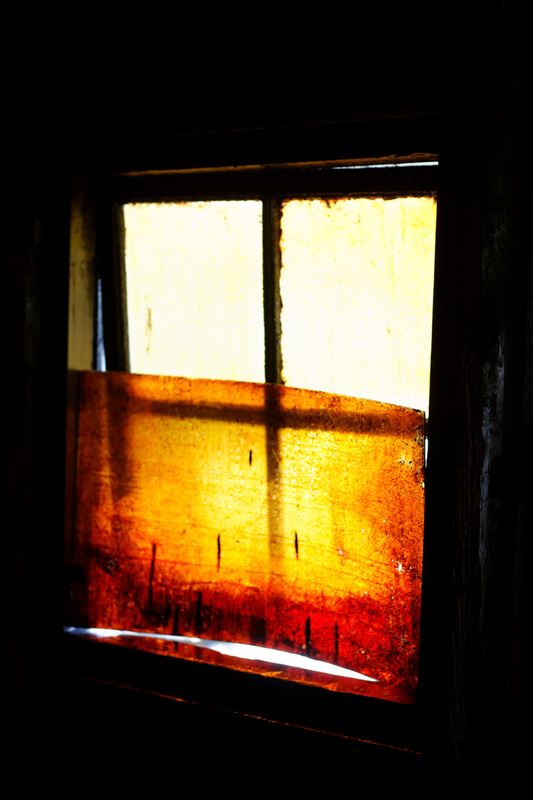
Window in the smoking house |
Similar posts
Finding farmhouse ale in Norway
Quite a few people write to me, saying they're planning to visit Norway, and want to know where they can experience Norwegian farmhouse ale culture
Read | 2019-07-14 10:39
Voss - farmhouse ale central
We'd booked a camping cabin in Voss, but because of confusion over the booking, we were moved into a huge house with lots of rooms instead
Read | 2014-07-20 15:32
Stjørdalsøl — the tasting
During our 2014 farmhouse ale expedition, Martin and I visited Stjørdal, a region in Norway famous for the many farmhouse brewers who still make their own malts in the traditional way
Read | 2017-03-09 14:58
Comments
Svein - 2014-07-25 07:41:07
Brilliant! The machine seems to be taken directly from the Wallace & Gromit movie "A Close Shave" :)
ERDENEBAT Gombo - 2015-01-01 10:16:27
Hello dear, a Happy new year! I`m from Mongolia. I`m looking for Smalahove processing machine. I need any connection about Smalahove. Could you help for my petition!
I`m hearing you.
Best regards,
Shane Johnson - 2023-04-03 20:01:07
Do you recall the parts of the head they remove and don't use? I'd like to try making one by hand. Thanks!
Lars Marius - 2023-04-03 20:08:56
@Shane: There isn't really anything they remove, as far as I know, except the brain. Here's a photo of a split head from the slaughterhouse. This one's pretty much ready. https://img.garshol.priv.no/photoserv.py?t415880